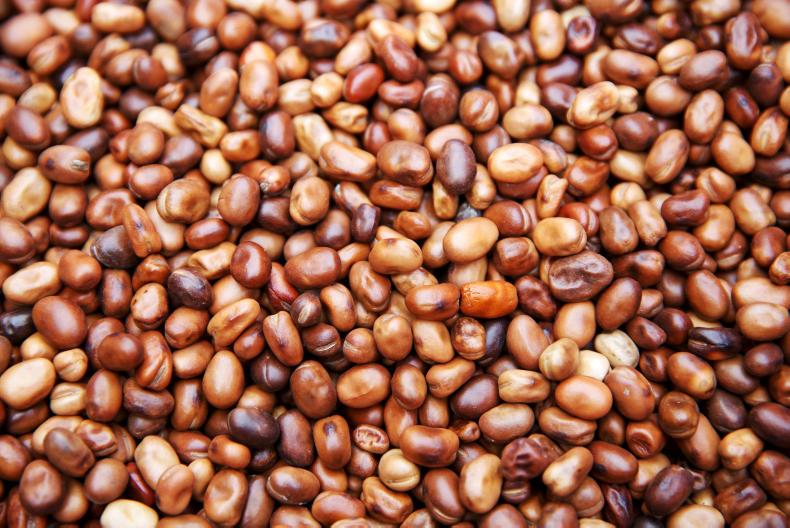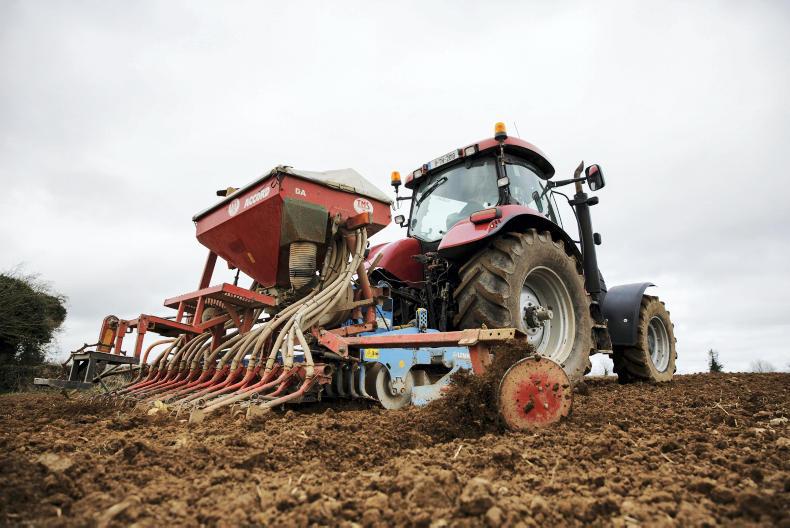While spring bean seed supplies may be tight this year, reports suggest demand is lower than anticipated.
Carryover seed supplies from 2017 are reported to have been the first to be planted, with 2018 seed now making up the bulk of the seed on the market.
While good progress has been made this week with planting, there is still more than enough time left to drill beans.
The area of spring beans peaked in 2017 at 11,444ha and crashed to 6,919ha in 2018.
Last autumn we saw a large swing to winter cereals which is contributing to the lower demand for bean seed this year.
Furthermore, with the increased planting of fodder crops last year, many rotations may not permit the planting of break crops such as beans this year.
But for those who are still on the fence about whether or not to plant beans, it’s worth remembering that while the crop proved a disaster for many in 2018, based on average yields achieved over the previous number of years, it is generally financially attractive. Moreover, given the current trends in the grain and straw markets, spreading the risk this year may prove an important management decision.
Don’t base yields on 2018
Most growers will find it hard to forget the sight of their blackened, dead bean crop last July. The crops which were worst affected yielded under 0.4t/ha.
But looking at results from the previous two years, the average yield ranged from 6.1-6.9t/ha.
These results are based on Teagasc e-Profit Monitor results from 2016 and 2017 for around 2,500 ha of beans.
The top one-third of growers were able to increase this yield by 0.4-0.6t/ha. At these yields and with the protein aid included, the financials soon make sense.
A look at the figures
When delving further into the performance of spring beans in 2016 and 2017, the green harvest prices received by growers ranged from €160-€163/t.
Average input costs on these farms ranged from €430-€450/ha and machinery costs around €250/ha.
In 2017, the average net margin per ha for beans (including land rental and protein payment) was €337/ha.
This crop outperformed spring feed barley with a green harvest price of €153/t, winter and spring oats at around €150/t and came close to matching spring malting barley at €159/t.
The net margin for spring beans increased to €428/ha for the top one-third of growers.
In 2016, average yields were lower. However, with land rental and the protein aid included, the crop still outperformed winter and spring feed barley valued at €141/t, spring malting barley at €155/t, spring oats at €143/t and winter and spring oilseed rape at around €350/t. The net margin again increased to €320/ha for the top one-third of growers that year.
What to expect for 2019
One useful tool when determining your cropping options is the annual Teagasc crops cost and returns booklet.
This gives a good steer as to the potential returns of each crop. However, since the publication of the 2019 edition, market signals have shifted, as have physical and harvest prices. This changes the economics of the crops considerably.
The booklet suggests green wheat prices of around €170/t, with barley at €160/t. Unfortunately, the latest harvest prices offered to the market put these valuations at around €10 over where they are likely to end up.
Furthermore, straw is valued at between €243/ha and €300/ha, a reflection of high straw prices in 2018.
The bean crop is among the few with an expected 2019 harvest price that isn’t to dissimilar from 2018 levels
While it is early in the season, straw prices are more likely to return to normal levels in 2019. These are the hard realities of the market and growers must be aware of them when making cropping decisions.
But let’s turn our attention back to spring beans. The minimum harvest price reported to have been offered for beans so far this year was €210/t.

Bean seed demand is lower than expected this spring.
The bean crop is among the few with an expected 2019 harvest price that isn’t to dissimilar from 2018 levels. With protein aid confirmed for 2019, the minimum growers are likely to receive is a payment of €250/ha.
Based on these revised figures, a 7t/ha crop of spring beans could potentially return a gross margin of around €800/ha (excluding land rental).
This gross margin would outperform an 11t/ha crop of winter wheat with a green harvest price of €162/t, a 10t/ha crop of winter barley at €152/t, an 8t/ha crop of feed and malting barley at €152/t and €190/t respectively and winter and spring oats valued at €155/t.
Key considerations
Production costs are largely up across the board, driven primarily by increased fertiliser costs.
Spring beans are once again expected to be one of the more inexpensive crops to grow, in part due to having no requirement for nitrogen.
The lower production costs will help mitigate the risk this year.
We may not know exactly where green grain price will finish up but what is known is that the cost of growing your cereal crop will be higher.
While spring beans won’t suit everyone or every location, where the crop can fit into the rotation and where you have a market for them, the crops makes sense.
Read more
Protein emphasis at Quinns seminar
Deadline for €220/t beans contract with Quinns extended to this Friday
While spring bean seed supplies may be tight this year, reports suggest demand is lower than anticipated.
Carryover seed supplies from 2017 are reported to have been the first to be planted, with 2018 seed now making up the bulk of the seed on the market.
While good progress has been made this week with planting, there is still more than enough time left to drill beans.
The area of spring beans peaked in 2017 at 11,444ha and crashed to 6,919ha in 2018.
Last autumn we saw a large swing to winter cereals which is contributing to the lower demand for bean seed this year.
Furthermore, with the increased planting of fodder crops last year, many rotations may not permit the planting of break crops such as beans this year.
But for those who are still on the fence about whether or not to plant beans, it’s worth remembering that while the crop proved a disaster for many in 2018, based on average yields achieved over the previous number of years, it is generally financially attractive. Moreover, given the current trends in the grain and straw markets, spreading the risk this year may prove an important management decision.
Don’t base yields on 2018
Most growers will find it hard to forget the sight of their blackened, dead bean crop last July. The crops which were worst affected yielded under 0.4t/ha.
But looking at results from the previous two years, the average yield ranged from 6.1-6.9t/ha.
These results are based on Teagasc e-Profit Monitor results from 2016 and 2017 for around 2,500 ha of beans.
The top one-third of growers were able to increase this yield by 0.4-0.6t/ha. At these yields and with the protein aid included, the financials soon make sense.
A look at the figures
When delving further into the performance of spring beans in 2016 and 2017, the green harvest prices received by growers ranged from €160-€163/t.
Average input costs on these farms ranged from €430-€450/ha and machinery costs around €250/ha.
In 2017, the average net margin per ha for beans (including land rental and protein payment) was €337/ha.
This crop outperformed spring feed barley with a green harvest price of €153/t, winter and spring oats at around €150/t and came close to matching spring malting barley at €159/t.
The net margin for spring beans increased to €428/ha for the top one-third of growers.
In 2016, average yields were lower. However, with land rental and the protein aid included, the crop still outperformed winter and spring feed barley valued at €141/t, spring malting barley at €155/t, spring oats at €143/t and winter and spring oilseed rape at around €350/t. The net margin again increased to €320/ha for the top one-third of growers that year.
What to expect for 2019
One useful tool when determining your cropping options is the annual Teagasc crops cost and returns booklet.
This gives a good steer as to the potential returns of each crop. However, since the publication of the 2019 edition, market signals have shifted, as have physical and harvest prices. This changes the economics of the crops considerably.
The booklet suggests green wheat prices of around €170/t, with barley at €160/t. Unfortunately, the latest harvest prices offered to the market put these valuations at around €10 over where they are likely to end up.
Furthermore, straw is valued at between €243/ha and €300/ha, a reflection of high straw prices in 2018.
The bean crop is among the few with an expected 2019 harvest price that isn’t to dissimilar from 2018 levels
While it is early in the season, straw prices are more likely to return to normal levels in 2019. These are the hard realities of the market and growers must be aware of them when making cropping decisions.
But let’s turn our attention back to spring beans. The minimum harvest price reported to have been offered for beans so far this year was €210/t.

Bean seed demand is lower than expected this spring.
The bean crop is among the few with an expected 2019 harvest price that isn’t to dissimilar from 2018 levels. With protein aid confirmed for 2019, the minimum growers are likely to receive is a payment of €250/ha.
Based on these revised figures, a 7t/ha crop of spring beans could potentially return a gross margin of around €800/ha (excluding land rental).
This gross margin would outperform an 11t/ha crop of winter wheat with a green harvest price of €162/t, a 10t/ha crop of winter barley at €152/t, an 8t/ha crop of feed and malting barley at €152/t and €190/t respectively and winter and spring oats valued at €155/t.
Key considerations
Production costs are largely up across the board, driven primarily by increased fertiliser costs.
Spring beans are once again expected to be one of the more inexpensive crops to grow, in part due to having no requirement for nitrogen.
The lower production costs will help mitigate the risk this year.
We may not know exactly where green grain price will finish up but what is known is that the cost of growing your cereal crop will be higher.
While spring beans won’t suit everyone or every location, where the crop can fit into the rotation and where you have a market for them, the crops makes sense.
Read more
Protein emphasis at Quinns seminar
Deadline for €220/t beans contract with Quinns extended to this Friday











SHARING OPTIONS